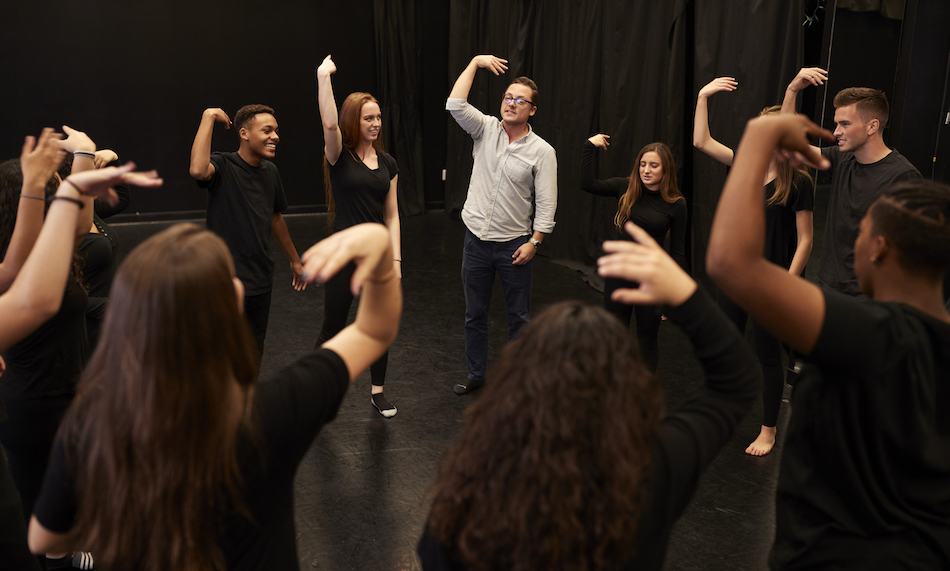
Improv name games are a great way to quickly get to know fellow improvisers, so you can feel more comfortable jumping into scene work together. I had a hard time finding a comprehensive list of these icebreakers, so here are some of my favorite improv name games, along with the other skills these improv warmups work.
Improv Name Games: At a Glance
Improv name games are icebreakers that allow improvisers to introduce themselves while practicing other key improv skills, like focus and agreement, which are essential for good scene work.
| Improv Name Game | Key Warmup Skills |
|---|---|
| Bumpity Bump Bump | Memory, thinking on your feet |
| Cross Circle | Eye contact, focus, listening, memory |
| Exaggeration Circle | Memory, making bold choices, physicality/movement |
| Group Juggle | Eye contact, focus, memory, physical coordination |
| Name Signals | Eye contact, focus, memory, physicality/movement |
| Name Signals 2.0 | Eye contact, focus, memory, physicality/movement |
| Name Volley | Memory, object work, physicality/big movements |
Click the links above or read on below to learn more about these improv icebreakers. I’ve used these name games in improv jams and open plays for the past three years, and while they seem simple, I’ve found they really help create a sense of cooperation and agreement between people who don’t know each other well.
Name Game #1: Bumpity Bump Bump
Great for: Memory, thinking on your feet
This improv name game requires you to remember your fellow improvisers’ names really quickly. Everyone stands in a circle and introduces themselves (especially the people n your immediate left and right).
To start the game, one person (person A) stands in the center and approaches a random person (person B) in the circle. S/he says either “left” or “right,” followed by “bumpity bump bump.” In the time it takes person A to say “left bumpitity bump bump,” person B must say the name of the person on their left (or right). If they succeed, person A approaches someone knew. If they fail, person B takes their place in the center.
You can also add “me” and “you” as options. If person A approaches person B and says “me bumpity bump bump,” person B has to say person A’s name before they finish speaking..
Name Game #2: Cross Circle
Great for: Eye contact, focus, listening, memory
Cross circle requires focus, good listening skills, and quick reactions, but it’s also lots of fun. To start this warmup exercise, gather everyone in a large circle and have everyone state their names for the group.
The game beings with one person (person A) looking across the circle at another person (person B), making eye contact and saying, “Hey, [name of person B].” Person B makes eye contact, acknowledging that person A said their name. Once this acknowledgment happens, person A immediately beings walking to take person B’s spot in the circle.
However, person B cannot move from his/her spot until they call out someone else’s name. Once they make eye contact with person C, say “Hey, [name],” and receive visual acknowledgment that person C heard them, they can begin walking to person C’s spot. The goal is for person B start moving toward person C’s spot before person A reaches them. Person C, in turn, cannot move until they call out someone else’s name.
Note: This game requires extremely good eye contact and nonverbal communication. It’s really important that when you say someone else’s name, you are certain that they have acknowledged it. Otherwise, someone will end up stuck in the middle.
This game usually gets really funny and hectic by the end, which can be great for getting improvisers warmed up and out of their heads.
Name Game #3: Exaggeration Circle
Great for: Memory, making bold choices, physicality/movement
This warmup game can be played with or without names, and it’s one of my favorites because it’s also a physical warmup. Everyone stands in a circle, and the first person says their name and makes a small motion. The next person in the circle repeats the first person’s name and movement but makes the movement just a little bit bigger. As the movement and name travel around the circle, each successive person makes the movement (and name) bigger and bigger, and the last person should make the motion as big and exaggerated as possible.
Then, the next player in the circle states their own name and creates a small movement, and the exaggeration circle starts again, until everyone has had a turn to start the circle.
Tip: In smaller groups, you can go around the circle 2 or 3 times before reaching maximum exaggeration.
Name Game #4: Group Juggle
Great for: Eye contact, focus, memory, physical coordination
You’ll need a ball, beanbag, or other small object for this simple improv warmup exercise. Everyone stands in a circle and introduces themselves. The first person calls out someone else’s name, making eye contact, then thros them the ball. That person makes eye contact with another person in the circle, making eye contact, and throws them the ball. And so on.
When you receive the ball, either raise your hand or set it on your head, so everyone who can see who has already received the ball. The round ends when everyone has received the ball once.
Once that round is over, you’ll start again – throwing the ball to the same people in the exact same order you did the first time. To make things complicated (because of course that’s the fun part), you can start the cycle again with a second ball, and everyone has to maintain the order with two seprate balls.
Name Game #5: Name Signals
Great for: Eye contact, focus, memory, physicality/movement
In this improv warmup, everyone stands in a circle. Each person should then state their name accompanied by a unique movement (for example, jumping up and down, or miming sipping a beverage). As each person introduces their name and signal, everyone in the circle should repeat the name and motion to help commit them to memory.
Once everyone has established their name/signal, person A will “pass” the signal to person B by (a) making eye contact with person B and (B) doing person B’s name and signal. Then, person B “accepts” the signal by repeating their own name/signal again. They can then pass the signal on to someone else by doing that third person’s name/signal.
For example, Sally might make eye contact with Mike, do Mike’s signal, and say “Mike!” Mike would then repeat his own name and signal, accepting the signal. Then, he’d pass the signal to a third person by doing their name/signal.
NOTE: It is very important to make eye contact with the person you are sending the signal to in this game. It’s also important to receive your own signal by repeating it, as this can help the other players’ remember your name/signal.
As the game goes on, speed up the pace. If you forget someone’s name or signal, just ask!
Name Game #6: Name Signals 2.0
Great for: Eye contact, focus, memory, physicality/movement
This is a variant on the Name Signals game, which you can add on to make the game more challenging. Once you’ve gotten the hang of calling out people’s names and doing their motions, ask for a suggestion from the group of something they’ve been thinking about that day. This can be anything: email, Alaska, rush hour traffic. Next, have everyone in the circle create a brand new signal consisting of a movement plus a sound, inspired by this suggestion.
Example: If the suggestion is rush hour traffic, one person might make a horn honking motion and say “beep!” Another might mime turning a radio dial and say “monotony.” (The sound can be a word/phrase or a wordless noise; the key is to make it short so people can remember it!)
You then play a round of the Name Signals game with these new signals, making eye contact and doing someone else’s sound/movement to “pass” the signal to them. They’ll then repeat their own signal to accept it and pass the signal on to the next person. Once you get into a rhythm, add the original name signals back into the mix. You can now pass the signal to someone by using either of their two signals.
Name Game #7: Name Volley
Great for: Memory, object work, physicality/big movements
This improv icebreaker mimics a game of volleyball, which is both a great physical warmup with object work and a fantastic way to learn others’ names.
First, break your group up into two teams with an imaginary volleyball net in between. Each team will mime playing volleyball, with serves, spikes, and misses, but whenever you hit the “ball” to the other side, you must call out the name of the person you’re hitting it to.
Have fun with the object work and with dramatic hits and big misses. By the end of this game, you’ll not only know everyone’s names, but you’ll have warmed your body too.
Check out this explanation of how to play from Expert Village:
Name games may seem silly at times, but they can be a great way to break the ice with a group of improvisers who don’t know each other well.
Did I miss any great improv name games? Let me know in the comments below!
